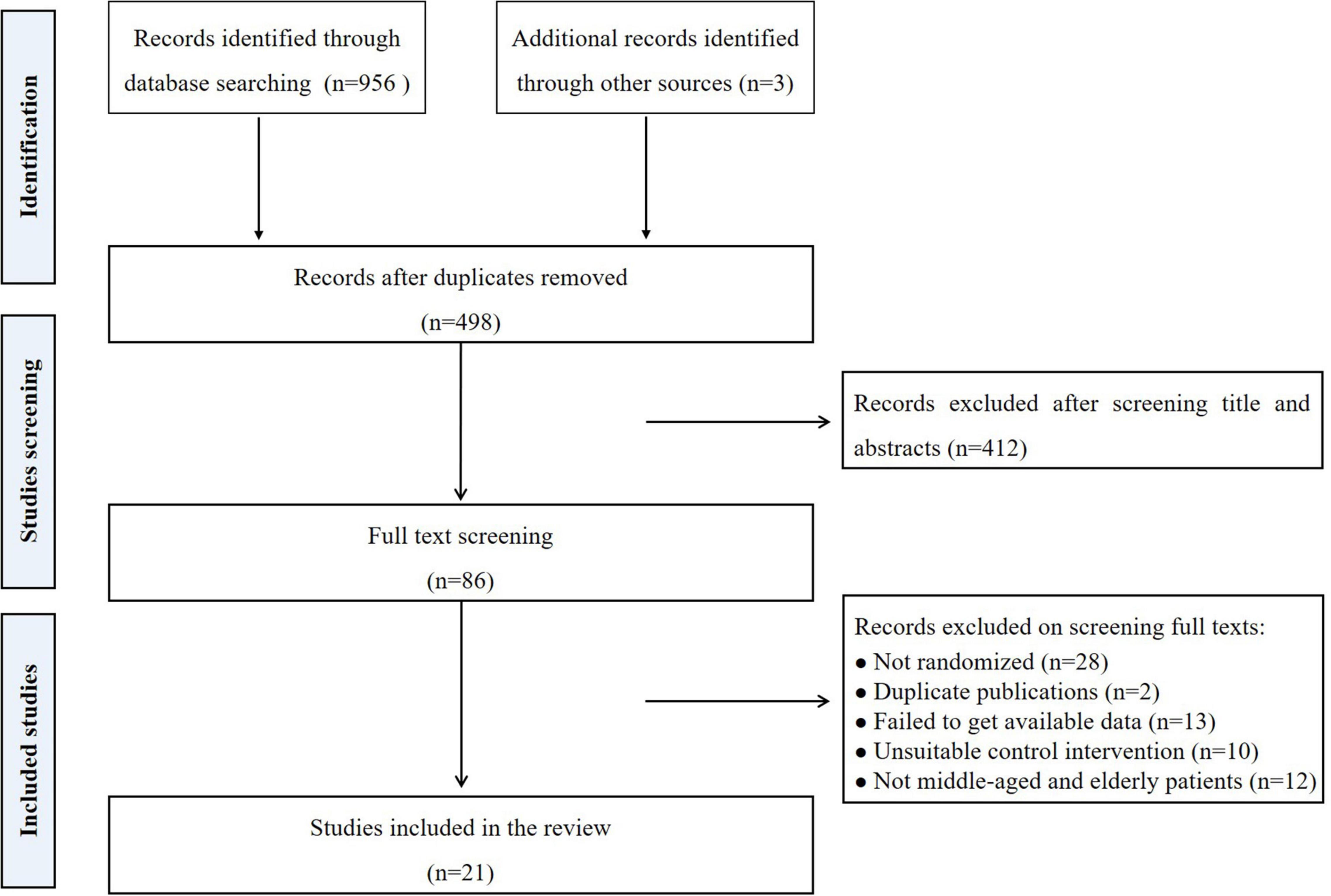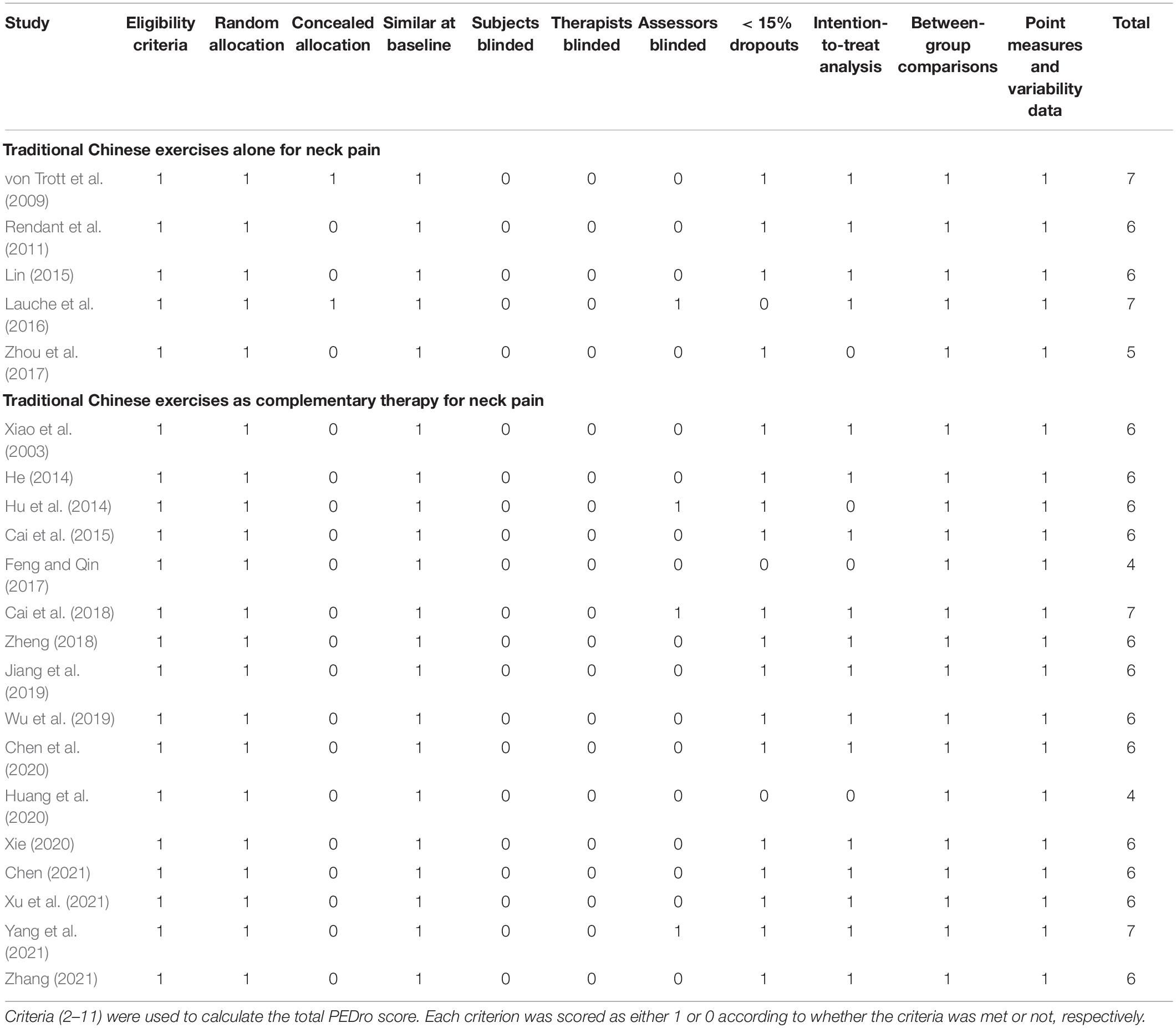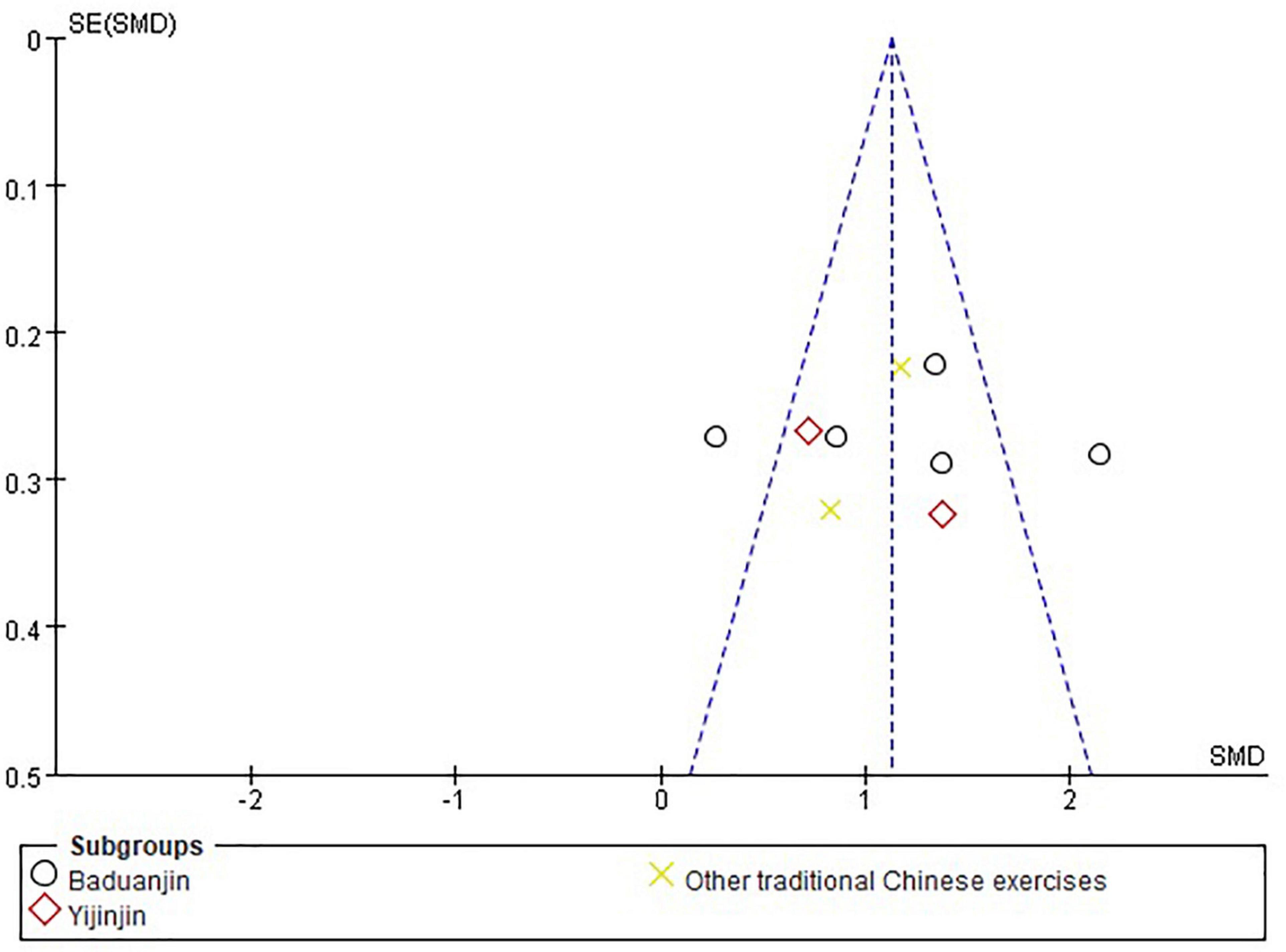- 1Yueyang Hospital of Integrated Traditional Chinese and Western Medicine, Shanghai University of Traditional Chinese Medicine, Shanghai, China
- 2Institute of Tuina, Shanghai Institute of Traditional Chinese Medicine, Shanghai, China
- 3Shuguang Hospital, Shanghai University of Traditional Chinese Medicine, Shanghai, China
Background: With the change of life and work style, more middle-aged and elderly individuals are suffering from neck pain. In China, traditional Chinese exercises (TCEs) are widely used in the management of neck pain, such as Tai Chi, Qigong, Yijinjing, Baduanjin, Liuzijue, and Five-animal exercises. However, the evidence of TCEs for neck pain maintains controversial. Therefore, the current systematic review was conducted to evaluate the effects of TCEs on pain and disability of middle-aged and elderly patients with neck pain.
Methods: A comprehensive literature search was performed in six electronic databases from their inception to January 2022 for randomized controlled trials of TCEs for neck pain. The methodological quality of the included studies was assessed by PEDro scale. The subgroup analysis was conducted based on different TCEs. The I2 statistic was applied to assess the heterogeneity.
Results: Twenty-one studies were included in our review, which were conducted in China, United States, and Germany between 2003 and 2021. Most (86%) of them exceeded the cut off score 6. TCEs included Baduanjin, Yijinjing, Tai Chi, Qigong, and Five-animal exercises. The aggregated results indicated that TCEs showed positive complementary effects in relieving pain (SMD, 1.12; 95% CI, 0.78–1.45; p < 0.00001), especially Baduanjin exercises. Baduanjin exercises also showed beneficial complementary effects in improving flexion (SMD, 0.65; 95% CI, 0.28–1.03; p = 0.0006) and extension (SMD, 0.66; 95% CI, 0.12–1.19; p = 0.02) of the neck. In addition, the aggregated results indicated that TCEs alone showed beneficial effects in improving disability (SMD, 0.74; 95% CI, 0.40–1.08; p < 0.0001) and relieving pain (SMD, 0.81; 95% CI, 0.50–1.13; p < 0.00001) compared with waiting list. The follow-up effects of TCEs were still insufficient.
Conclusion: There was the positive evidence to support the clinical use of TCEs, as a complementary therapy, for middle-aged and elderly patients with neck pain, especially Baduanjin exercises. However, the evidence supporting the effects of TCEs alone for the middle-aged and elderly patients with neck pain was limited due to the small sample size.
Systematic Review Registration: https://inplasy.com/inplasy-2022-4-0083/, identifier INPLASY202240083.
Introduction
Neck pain is a common musculoskeletal condition with a high incidence rate, and it is the fourth leading cause of years lived with a disability around the world (Vos et al., 2012). The estimated annual incidence of neck pain ranged between 10.4 and 21.3% (Hoy et al., 2010), with a higher incidence in middle-aged office workers and elderly population. In China, the incidence rate of neck pain was up to 24.66%, and it increases with age. The prevalence of neck pain was 34.94% among people over 60 years old (Xu, 2019). More than 60% patients with neck pain may experience the second neck pain within 1 year (Carroll et al., 2008). It places a significant burden on the patients with neck pain and social healthcare systems due to the treatment costs, work absenteeism, and reduced productivity (Cote et al., 2013). The study reported that 14.2% patients with neck pain have multiple episodes of work absenteeism within 2 years of their initial health claims due to neck pain (Van Eerd et al., 2011).
Health professionals and patients still face tremendous challenges on the management of neck pain due to a variety of treatment strategies and conflicting reports on its treatments (Cohen, 2015). Considering drug dependence and poor stability of the spine after neck surgery, more patients turn to choose complementary and alternative therapies for neck pain to relieve pain and improve quality of life. Exercises have been recommended to prevent and treat neck pain by the clinical guidelines (Bussières et al., 2016). Common exercise therapies for neck pain include range-of-motion exercise, aerobic exercise, supervised exercise, strengthening exercise, and yoga, which can possibly alleviate neck pain because of their ability to improve muscle strength, flexibility, and endurance as well as restore injured tissues (Jordan et al., 1997; Wolsko et al., 2003; Kose et al., 2007).
In China, traditional Chinese exercises (TCEs) are widely used in the treatment of neck pain and associated conditions, which include Tai Chi, Qigong, Yijinjing, Baduanjin, Liuzijue, and Five-animal exercises (Xie et al., 2021). TCEs take both body and mind into account, emphasize the coordination and unification of breathing and body movements under the guidance of consciousness, and exercise the muscles and joints of the whole body (Lan et al., 2013; Solloway et al., 2016). They may also improve balance, aerobic capacity, and regulate the cervical balance of dynamic and static mechanics, so as to improve neck function, control posture, and relieve pain (Kuo et al., 2021). The study also reported that the movements of TCEs are thought to relax the mind and body to dilate blood vessels and promote local blood circulation (Huston and McFarlane, 2016). As one of low to moderate-intensity mind-body exercises, TCEs may have similar health benefits with common exercise therapy, but experience lower energy metabolism. These traditional mind-body exercises are suitable for middle-aged and elderly patients with neck pain and mental health conditions. Some studies (von Trott et al., 2009; Lauche et al., 2016; Huang et al., 2020) reported the positive effects of TCEs in the management of neck pain. However, the previous review (Xie et al., 2021) showed that there was insufficient evidence to support the effects of TCEs in improving pain intensity and enhancing functional mobility in individuals with neck pain. The evidence of TCEs for neck pain maintains controversial.
Therefore, the current systematic review evaluated the effects of TCEs on pain and disability in middle-aged and elderly patients with neck pain. It provided evidence-based information for the clinical application of TCEs for neck pain.
Methods
The systematic review was registered on the international platform of registered systematic review and meta-analysis. The registration number is INPLASY202240083.
Search Strategy
A computerized literature search was conducted to identify the potential eligible studies in the following electronic databases from their inceptions to January 2022: PubMed, EMBASE, Web of Science, China National Knowledge Infrastructure (CNKI), Wanfang Degree and Conference Papers Database, and Chinese Science and Technology Periodical (VIP) Databases. The key searching terms were (“traditional Chinese exercises” OR “Tai Chi” OR “tai ji” OR “Baduanjin” OR “Yijinjing” OR “Qigong” OR “Liuzijue” OR “Five-animal exercises” OR “Wuqinxi”) and (“neck pain” OR “cervical spondylopathy” OR “cervical pain”). Additional studies were identified by scanning the reference list of relevant reviews. The World Health Organization International Clinical Trials Registry Platform (ICTRP) and the Chinese Clinical Trial Registry (ChiCTR) were searched to identify the ongoing or unpublished studies. When necessary, the reviewers contacted the study authors. There were no restrictions on publication language or status.
Study Selection
According to the inclusion and exclusion criteria, the literature selection was performed by two reviewers independently. In this review, the inclusion and exclusion criteria were: (1) Types of study: randomized control trials (RCTs). (2) Types of participants: participants with a clinical diagnosis of neck pain, and the average age more than 40 years at least one group. There were no limitations on gender or nationality. (3) Types of interventions: TCEs were Tai Chi, Baduanjin, Yijinjing, Qigong, Liuzijue, and Five-animal exercises. The control interventions included waiting list, education, routine rehabilitation therapy, acupuncture, medicine, other modern exercise therapy, and any treatments without TCEs. (4) Types of outcomes: pain was measured by the visual analogue scale (VAS), functional mobility of the neck was assessed using the neck disability index (NDI), quality of life was assessed using the 36-item short form health survey (SF-36), and cervical range of motion such as flexion, extension, lateral-flexion, and rotation.
Trials that met any of the following criteria were excluded: (1) quasi-randomized RCTs and non-randomized trials, (2) duplicated publications, and (3) unavailable full text or missing data. Any disagreements were resolved by discussion between two reviewers.
Data Extraction
The data extraction was independently performed by two reviewers based on pre-defined criteria. The following data were collected: (1) basic information such as the name of the first author, year, and country of publication; (2) characteristics of the participants such as sample size and mean age; (3) information regarding study design such as interventions, outcomes, and follow-up duration. Only the first phase data were extracted in the crossover studies. Any disagreements were resolved by discussion between two reviewers.
Quality Assessment
Two reviewers independently assessed the methodological quality of the included trials by the Physiotherapy Evidence Database (PEDro) scale. The PEDro scale is a multi-item scale consisting of 11 items to measure the methodological quality of RCTs of physiotherapy interventions. The PEDro scale includes: (1) study eligibility criteria specified, (2) random allocation of subjects, (3) concealed allocation, (4) measure of similarity between groups at baseline, (5) subject blinding, (6) therapist blinding, (7) assessor blinding, (8) less than 15% dropouts, (9) intention-to-treat analysis, (10) between-group statistical comparisons, and (11) point measures and variability data. The PEDro score of 0–10 is obtained by summation (item 1 is not scored), and a cut point of 6 indicates high-quality studies. The PEDro score has been demonstrated to be valid and reliable for assessing methodological quality of physiotherapy RCTs (Maher et al., 2003; de Morton, 2009). Any disagreements were resolved by obtaining the consensus of all reviewers.
Data Synthesis and Analysis
The meta-analysis was conducted using the RevMan version 5.3 (The Cochrane Collaboration, Software Update, Oxford, United Kingdom). For the continuous outcomes, the between-groups mean differences of the studies were converted to the standardized mean difference (SMD) with 95% confidence intervals (CIs) in the meta-analysis. A random effects model was used for better dealing with the clinical heterogeneity. The heterogeneity was evaluated using the I2 statistic: I2 > 30% suggests moderate heterogeneity, I2 > 50% represents substantial heterogeneity, and I2 > 75% considerable heterogeneity. The subgroup analysis was conducted based on different TCEs and control interventions. The risk of publication bias was assessed by funnel-plot if more than nine trials were included in the meta-analysis. Results were considered statistically significant for p < 0.05.
Results
Search and Selection
In our initial search, a total of 959 articles were found. A total of 461 of them were duplicates and thus excluded. A total of 412 studies were excluded after screening the titles and abstracts. After screening the full texts, 21 studies were included in our review. The detailed process was showen in Figure 1.
Characteristics of the Included Studies
A total of 1,770 participants with a mean age of 49.59 ± 9.27 years were included in eligible 21 RCTs, which were conducted in China, United States, and Germany from 2003 to 2021. Sixteen studies used TCEs as a complementary therapy for neck pain. Five studies used TCEs alone for neck pain. In the included studies, TCEs included Baduanjin, Yijinjing, Tai Chi, Qigong, and Five-animal exercises. TCEs were combined with acupuncture, Tuina, routine rehabilitation, and medicine for neck pain in the included studies. The exercise duration was between 20 days and 24 weeks. The time of each exercise was between 5 and 90 min. The exercise ranged from 12 to 240 sessions. The follow-up time ranged from 12 to 24 weeks. The control intervention included waiting list, education, traction, acupuncture, Tuina, routine rehabilitation, medicine, and other exercises. The main outcomes included neck pain, neck disability, quality of life, and cervical range of motion. The main characteristics of all included RCTs were shown in Table 1.
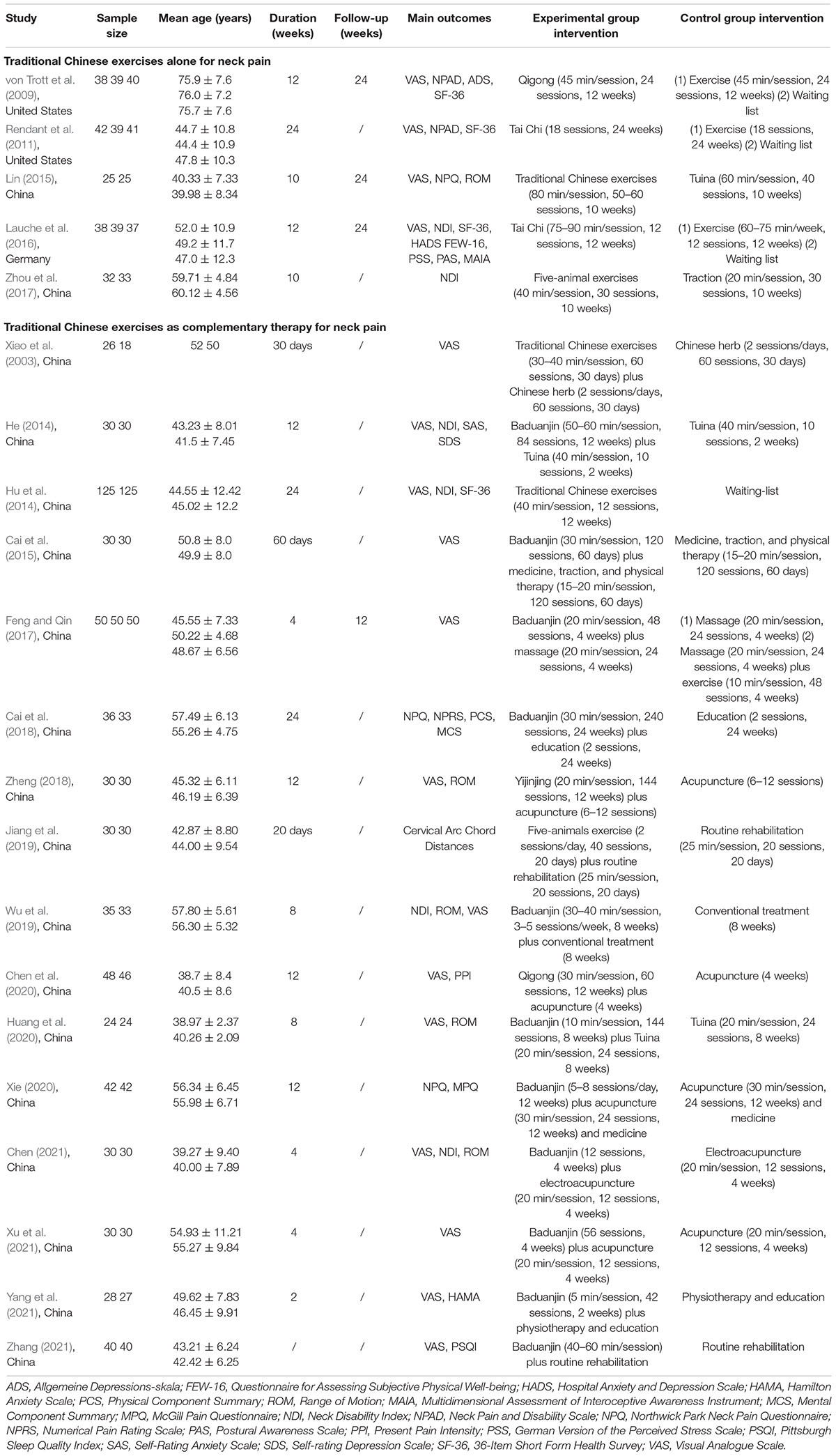
Table 1. Randomized controlled trials evaluating the effects of traditional Chinese exercises for neck pain.
Methodological Quality
Based on the PEDro scale, most (86%) of the included studies have good methodological quality with the scores ranging from 6 to 7 points. The most common flaws were blinding methods in these studies. Blinding of subjects and therapies were absent in all included RCTs. Only 2 RCTs describe concealed allocation in details (von Trott et al., 2009; Lauche et al., 2016). The assessor blinding was performed in 4 included studies (Hu et al., 2014; Lauche et al., 2016; Cai et al., 2018; Yang et al., 2021). In addition, four trials rated the intention-to-treat negative (Hu et al., 2014; Feng and Qin, 2017; Zhou et al., 2017; Huang et al., 2020), and three studies showed > 15% dropouts (Lauche et al., 2016; Feng and Qin, 2017; Huang et al., 2020). Other items were scored positive in the included studies. The detailed scores were shown in Table 2.
Pain
As a complementary therapy, fifteen studies reported the complementary effects in relieving pain of TCEs for neck pain. Nine studies were included in the meta-analysis. The aggregated results indicated that the TCEs showed positive complementary effects in relieving pain (SMD, 1.12; 95% CI, 0.78–1.45; p < 0.00001, Figure 2A), especially Baduanjin (SMD, 1.19; 95% CI, 0.61–1.78; p < 0.0001, Figure 2A) and Yijinjing (SMD, 1.02; 95% CI, 0.39–1.65; p = 0.002, Figure 2A).
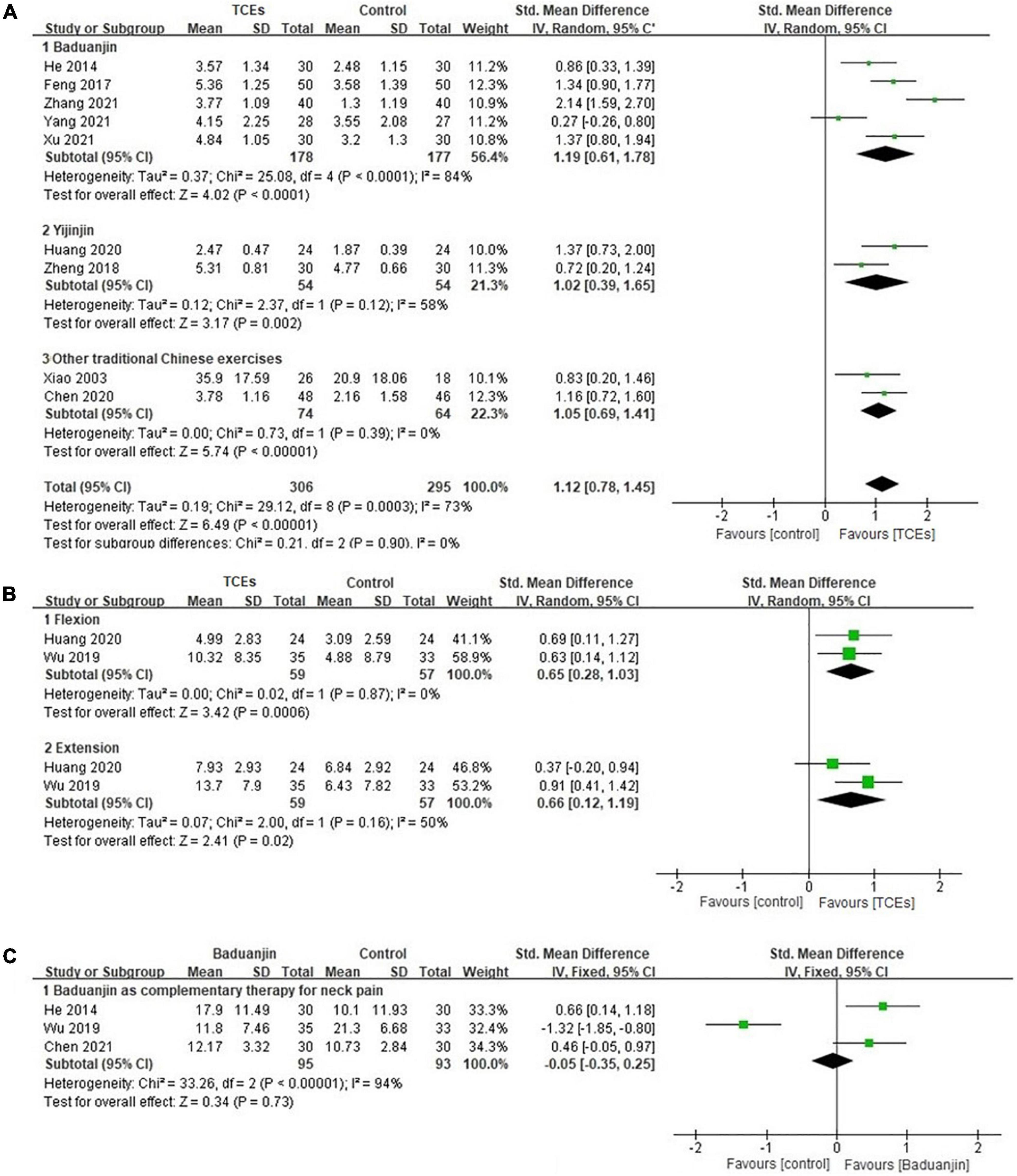
Figure 2. Forest plot of the complementary effects of traditional Chinese exercises (TCEs) for neck pain: (A) Pain, (B) range of motion, and (C) disability.
As an independent therapy, four studies reported the effects in relieving pain of TCEs for neck pain. All of them were included in the meta-analysis. The aggregated results indicated that TCEs alone showed better effects in improving pain (SMD, 0.81; 95% CI, 0.50–1.13; p < 0.00001, Figure 3A) compared with waiting list. But the aggregated results did not show better effects of TCEs alone in relieving pain compared with other exercises (SMD, 0.07; 95% CI, –0.18 to 0.33; p = 0.58, Figure 3A).
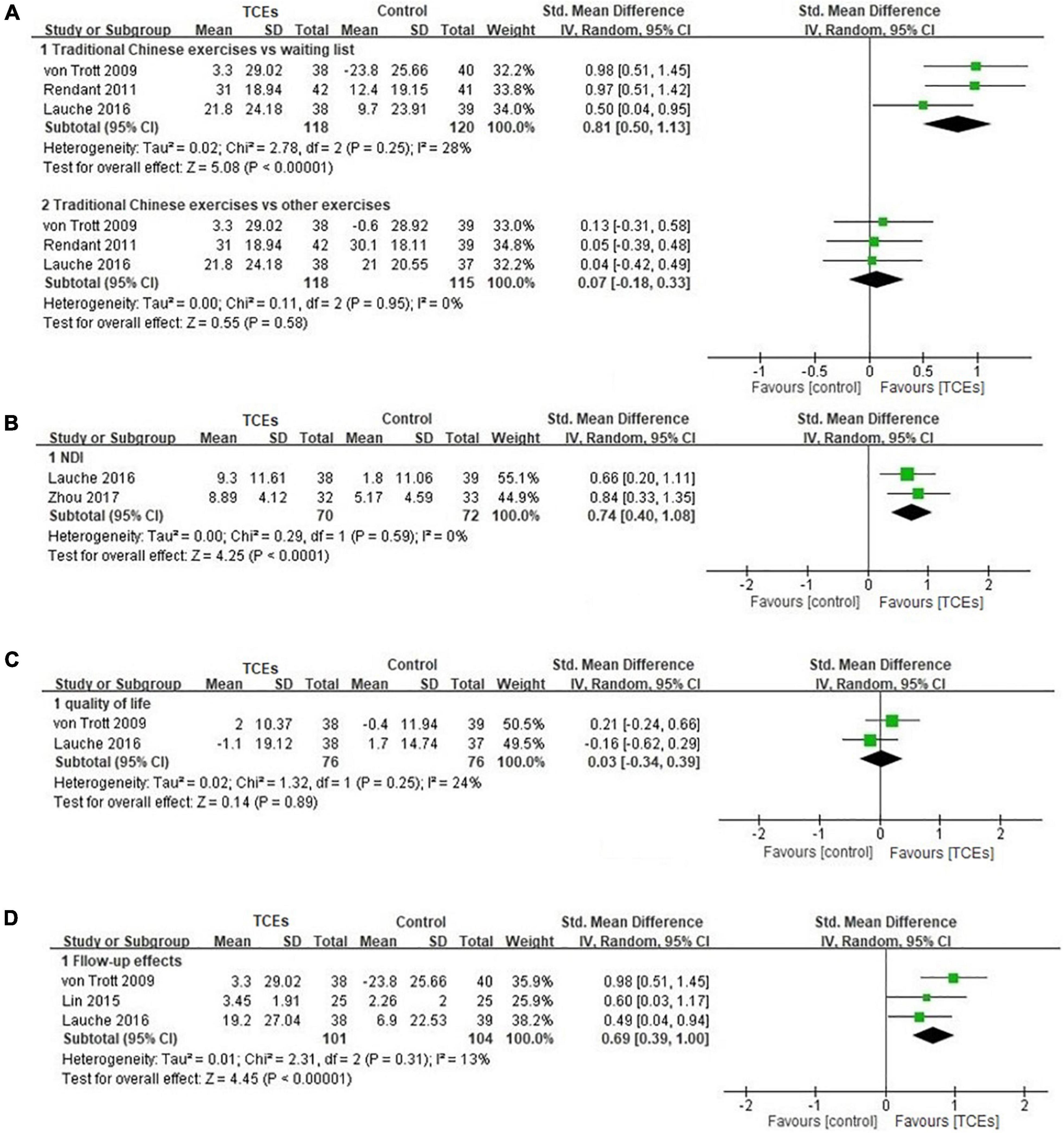
Figure 3. Forest plot of the effects of traditional Chinese exercises (TCEs) alone for neck pain: (A) Pain, (B) neck disability index (NDI), (C) quality of life, and (D) follow-up effects on pain.
Disability
As a complementary therapy, six studies reported the complementary effects in improving disability of TCEs for neck pain. Four of them were included in the meta-analysis. Baduanjin exercises showed beneficial effects in improving flexion (SMD, 0.65; 95% CI, 0.28–1.03; p = 0.0006, Figure 2B) and extension (SMD, 0.66; 95% CI, 0.12–1.19; p = 0.02, Figure 2B) of the neck. However, the aggregated result did not show that Baduanjin exercises had better complementary effects in improving disability (SMD, –0.05; 95% CI, –0.35 to 0.25; p = 0.73, Figure 2C).
As an independent therapy, the aggregated result showed beneficial effects of TCEs in improving disability of patients with neck pain (SMD, 0.74; 95% CI, 0.40–1.08; p < 0.0001, Figure 3B).
Quality of Life
In the included studies, only three studies reported the effects of TCEs on quality of life in patients with neck pain. In the meta-analysis, the aggregated result did not show better effects of TCEs alone on quality of life in patients with neck pain (SMD, 0.03; 95% CI, –0.34 to 0.39; p = 0.89, Figure 3C). Hu et al. (2014) reported that 24-weeks TCEs showed potential effects in quality of life in patients with neck pain, especially for mental health.
The Follow-Up Effects
In the follow-up effects, the aggregated results indicated that TCEs alone showed beneficial effects in relieving pain (SMD, 0.69; 95% CI, 0.39–1.00; p < 0.00001, Figure 3D). Feng and Qin (2017) reported that participants in Baduanjin group experienced less pain recurrence compared with massage group (7.14% vs. 20.83%) after 3 months follow-up.
Publication Bias
The funnel plots for TCEs for neck pain in relieving pain including 9 RCTs, respectively, in Figure 4. The publication bias was small because the spots were substantially symmetric.
Adverse Events
TCEs are considered to be safer movements, but there were some minor adverse events such as nausea, aching muscles, muscle tension, and falls and abrasions (von Trott et al., 2009; Lauche et al., 2016).
Discussion
The current systematic review and meta-analysis were conducted to evaluate the effects of TCEs for neck pain. The peak prevalence of neck pain usually is occurred in the middle-aged and elderly populations; thus the average age of included participants was limited (more than 40 years). In most included studies, TCEs were used as a complementary therapy for neck pain. There are encouraging results suggesting that TCEs have complementary effects in improving pain of middle-aged and elderly patients with neck pain, especially Baduanjin exercises. Baduanjin exercises also showed beneficial effects in improving the range of cervical motion of middle-aged and elderly patients with neck pain. However, Baduanjin exercises did not show better complementary effects in improving disability of patients with neck pain, which may be related to fewer included studies. There was not enough evidence on the follow-up effects of TCEs for middle-aged and elderly patients with neck pain. As a complementary therapy, TCEs may provide more improvements in cervical balance, postural control, and blood circulation to relieve pain (Huston and McFarlane, 2016; Kuo et al., 2021). In addition, the middle-aged and elderly individuals could have similar health benefits through low to moderate-intensity TCEs, but experience lower metabolic energy.
As an independent therapy, the results supported the positive effects in relieving pain of TCEs alone compared with waiting list, but no significant differences were shown for effects of TCEs alone in relieving pain compared with other exercises. It indicates that TCEs may be similar as exercise therapy in relieving neck pain. Guidelines recommend exercise therapy as the first-line non-pharmacological therapy for neck pain (Bussières et al., 2016). Compared with common exercise therapy, TCEs have lower energy metabolism and similar health benefits. However, the mechanism of TCEs in the treatment of neck pain is not clear. They may also improve aerobic capacity and regulate the cervical balance of dynamic and static mechanics, so as to improve neck function, control posture, and relieve pain (Kuo et al., 2021). TCEs combined deep breathing with physical movements, and may have an influence on negative emotions. A study suggested that TCEs may reduce pain-related symptoms by improving cognitive appraisal outcomes such as anxiety and depression (Hall et al., 2016). Negative emotions usually originate from the chronic musculoskeletal pain. However, most included studies did not focus on mental health of patients with neck pain. Thus, TCEs did not show better effects in quality of life in middle-aged and elderly patients with neck pain. In our review, the aggregated result showed beneficial effects of TCEs in improving disability of middle-aged and elderly patients with neck pain, but it was based on the small sample size. In further studies, more high-quality evidence will be needed to support the effects of TCEs alone for middle-aged and elderly patients with neck pain.
The previous systematic review reported that there was insufficient evidence to support the clinical use of TCEs in improving pain intensity and enhancing functional mobility and quality of life in individuals with neck pain (Xie et al., 2021). However, there were only six studies of TCEs for neck pain published in English. TCEs were widely used for musculoskeletal pain in China; however, the studies published in China were excluded in their review. Therefore, there was a significant publication bias in their results. These Chinese studies of TCEs for neck pain were included in our review. TCEs usually were used as a complementary therapy for neck pain in China. In our review, the included studies used TCEs plus routine rehabilitation, acupuncture, Tuina, or medicine for neck pain. Therefore, the complementary effects and independent effects of TCEs for neck pain were evaluated separately in our review. In addition, the subgroup analysis was conducted based on different TCEs in our meta-analysis. The previous systematic review also showed similar results with our review. Li et al. (2021) reported that TCEs could effectively relieve the clinical symptoms of patients with musculoskeletal pain. Therefore, there was more powerful evidence of TCEs for neck pain in our review.
Limitation
There are several limitations in this review. First, a rigorous search strategy was applied in our review, but there may be some uncertainty bias in location and publication (Moncrieff et al., 1998). Second, only RCTs were included in our review, but it was impossible to blind the patients and therapists in the studies of TCEs. The blinded outcome assessors and concealed allocations could partly compensate for these flaws, but only two trials used concealed allocation and four studies blinded the outcome assessors. Third, the subgroup analysis based on different TCEs was only conducted on the complementary effects in relieving pain. In other outcomes, detailed subgroup analysis was not performed due to insufficient eligible studies. Forth, our results may be affected by the different style, frequency, duration, and session of TCEs. Further reviews should focus on the parameters of TCEs if there are enough eligible studies. Fifth, the result of this review may be influenced by the type of neck pain, but the subgroup analysis could not be conducted due to few included studies. However, it is certain that the neck pain originates from the cervical degenerative diseases in most included studies. Finally, it was suspicious that most included studies conducted in China had non-participants dropout.
Conclusion
The current systematic review demonstrated that there was the positive evidence to support the clinical use of TCEs, as a complementary therapy, in relieving pain of middle-aged and elderly patients with neck pain, especially Baduanjin exercises. However, the evidence supporting the effects of TCEs alone in improving pain and disability of middle-aged and elderly patients with neck pain was limited due to the small sample size. The follow-up effects of TCEs were still insufficient.
Data Availability Statement
The original contributions presented in the study are included in the article/supplementary material, further inquiries can be directed to the corresponding author/s.
Author Contributions
LK, JR, XZ, and MF conserved and designed the study. TH and JR performed the literature search. JR and SF identified and selected the studies. LK and XZ assessed the methodological quality and extracted data. LK, XZ, and MF performed data synthesis and analysis. LK, JR, SF, XZ, and MF wrote the draft manuscript. All authors contributed to the article and approved the submitted version.
Funding
This work was supported by the Shanghai Pujiang Program (21PJD071), Talent Development Program in Shanghai (2019048), Innovation Team and Talents Cultivation Program of National Administration of Traditional Chinese Medicine (ZYYCXTD-C-202008), and Clinical Research Plan of SHDC (SHDC2020CR4055).
Conflict of Interest
The authors declare that the research was conducted in the absence of any commercial or financial relationships that could be construed as a potential conflict of interest.
Publisher’s Note
All claims expressed in this article are solely those of the authors and do not necessarily represent those of their affiliated organizations, or those of the publisher, the editors and the reviewers. Any product that may be evaluated in this article, or claim that may be made by its manufacturer, is not guaranteed or endorsed by the publisher.
References
Bussières, A. E., Stewart, G., Al-Zoubi, F., Decina, P., Descarreaux, M., Hayden, J., et al. (2016). The treatment of neck pain-associated disorders and whiplash-associated disorders: a clinical practice guideline. J. Manipulative Physiol. Ther. 39, 523–564.e27. doi: 10.1016/j.jmpt.2016.08.007
Cai, J., XIao, H., Shi, X., and Liu, T. (2015). Eight Duan Jin exercises combined with conventional therapy rehabilitation observation of 30 cases of neurogenic cervical spondylosis. Chin. Med. Herald 21, 98–99. doi: 10.13862/j.cnki.cn43-1446/r.2015.01.036
Cai, Y., Liu, A., Yao, Z., Li, J., and Wang, Y. (2018). The effect of Ba Duan Jin on the quality of life of middle-aged and elderly people with chronic neck pain. Chin. J. Gerontol. 38, 2934–2936.
Carroll, L. J., Hogg-Johnson, S., Côté, P., van der Velde, G., Holm, L. W., Carragee, E. J., et al. (2008). Course and prognostic factors for neck pain in workers: results of the Bone and Joint Decade 2000-2010 Task Force on Neck Pain and Its Associated Disorders. Spine 33, S75–82. doi: 10.1097/BRS.0b013e31816445d4
Chen, C., Mi, J., Rastiti, I. A., Zhang, X., Wang, L., Zheng, H., et al. (2020). Research on the supplementary therapeutic effect of fitness qigong on nerve root type cervical spondylosis. Shanghai Med. 41, 8–10.
Chen, X. (2021). Clinical Observation of Elector-Acupuncture Combined with Two Actions of Baduanjin Exercise in the Treatment of Cervical Spondylosis, Ph.D thesis, Guangzhou: Guangzhou University of Chinese Medicine.
Cohen, S. P. (2015). Epidemiology, diagnosis, and treatment of neck pain. Mayo Clin. Proc. 90, 284–299. doi: 10.1016/j.mayocp.2014.09.008
Cote, P., Yang, X., Kristman, V., Hogg-Johnson, S., Van Eerd, D., Rezai, M., et al. (2013). The association between workers compensation claims involving neck pain and future health care utilization: a population-based cohort study. J. Occup. Rehabil. 23, 547–556. doi: 10.1007/s10926-012-9415-8
de Morton, N. A. (2009). The PEDro scale is a valid measure of the methodological quality of clinical trials: a demographic study. Aust. J. Physiother. 55, 129–133. doi: 10.1016/s0004-9514(09)70043-1
Feng, L., and Qin, M. (2017). The efficacy of Ba Duan Jin on the clinical rehabilitation of patients with neurogenic cervical spondylosis. Massage Rehabil. Med. 8, 20–22. doi: 10.19787/j.issn.1008-1879.2017.24.008
Hall, A. M., Kamper, S. J., Emsley, R., and Maher, C. G. (2016). Does pain-catastrophising mediate the effect of tai chi on treatment outcomes for people with low back pain? Complement Ther. Med. 25, 61–66. doi: 10.1016/j.ctim.2015.12.013
He, X. (2014). The Research of Rehabilitation Effect on Neck Type Cervical Spondylosis Disease Patients by Baduanjin, Ph.D thesis, Nanjing: Nanjing University of Traditional Chinese Medicine.
Hoy, D. G., Protani, M., De, R., and Buchbinder, R. (2010). The epidemiology of neck pain. Best Pract. Res. Clin. Rheumatol. 24, 783–792. doi: 10.1016/j.berh.2011.01.019
Hu, Z., Tang, Z., Wang, S., Ye, X., Wang, Y., Shi, Q., et al. (2014). A 12-words-for-life-nurturing exercise program as an alternative therapy for cervical spondylosis: a randomized controlled trial. ECAM 2014:961418. doi: 10.1155/2014/961418
Huang, N., Guo, H., Li, Y., Xu, R., Wu, L., and Dou, S. (2020). The efficacy of orthopaedic massage combined with Yi Jin Jing “To Tian Style” on cervical cervical spondylosis. Fujian Chin. Med. 51, 19–21. doi: 10.13260/j.cnki.jfjtcm.011959
Huston, P., and McFarlane, B. (2016). Health benefits of tai chi: what is the evidence? Can. Fam. Phys. 6, 881–890.
Jiang, Y., Wang, M., Xu, L., Hao, Q., Yan, X., Wang, C., et al. (2019). The effect of Five Animal Play on cervical curvature in patients with cervical spondylosis. Massage Rehabil. Med. 10, 1–2. doi: 10.19787/j.issn.1008-1879.2019.23.01
Jordan, A., Mehlsen, J., and Ostergaard, K. (1997). A comparison of physical characteristics between patients seeking treatment for neck pain and age-matched healthy people. J. Manipulative Physiol. Ther. 20, 468–475.
Kose, G., Hepguler, S., Atamaz, F., and Oder, G. (2007). A comparison of four disability scales for Turkish patients with neck pain. J. Rehabil. Med. 39, 358–362. doi: 10.2340/16501977-0060
Kuo, C.-C., Chen, S.-C., Wang, J.-Y., Ho, T.-J., and Lu, T.-W. (2021). Best-compromise control strategy between mechanical energy expenditure and foot clearance for obstacle-crossing in older adults: effects of Tai-Chi Chuan practice. Front. Bioeng. Biotechnol. 9:774771. doi: 10.3389/fbioe.2021.774771
Lan, C., Chen, S.-Y., Lai, J.-S., and Wong, A. M.-K. (2013). Tai chi chuan in medicine and health promotion. ECAM 2013:502131. doi: 10.1155/2013/502131
Lauche, R., Stumpe, C., Fehr, J., Cramer, H., Cheng, Y. W., Wayne, P. M., et al. (2016). The effects of Tai Chi and neck exercises in the treatment of chronic nonspecific neck pain: a randomized controlled trial. J. Pain 17, 1013–1027. doi: 10.1016/j.jpain.2016.06.004
Li, Z., Zhuang, J., Zhang, S., He, Q., Zhao, R., Alima, T., et al. (2021). Therapeutic effects of traditional Chinese exercises on musculoskeletal pain: a systematic review and meta-analysis. Pain Res. Manag. 2021:5584997. doi: 10.1155/2021/5584997
Lin, Q. (2015). Research on the effect of fitness qigong on the rehabilitation of cervical cervical spondylosis in middle-aged and elderly people. J. Tonghua Normal Coll. 36, 111–113. doi: 10.13877/j.cnki.cn22-1284.2015.04.037
Maher, C. G., Sherrington, C., Herbert, R. D., Moseley, A. M., and Elkins, M. (2003). Reliability of the PEDro scale for rating quality of randomized controlled trials. Phys. Ther. 83, 713–721. doi: 10.1093/ptj/83.8.713
Moncrieff, J., Wessely, S., and Hardy, R. (1998). Meta-analysis of trials comparing antidepressants with active placebos. Br. J. Psychiatry 172, 227–234. doi: 10.1192/bjp.172.3.227
Rendant, D., Pach, D., Lüdtke, R., Reisshauer, A., Mietzner, A., Willich, S. N., et al. (2011). Qigong versus exercise versus no therapy for patients with chronic neck pain: a randomized controlled trial. Spine 36, 419–427. doi: 10.1097/BRS.0b013e3181d51fca
Solloway, M. R., Taylor, S. L., Shekelle, P. G., Miake-Lye, I. M., Beroes, J. M., Shanman, R. M., et al. (2016). An evidence map of the effect of Tai Chi on health outcomes. Syst. Rev. 5:126. doi: 10.1186/s13643-016-0300-y
Van Eerd, D., Côté, P., Kristman, V., Rezai, M., Hogg-Johnson, S., Vidmar, M., et al. (2011). The course of work absenteeism involving neck pain: a cohort study of Ontario lost-time claimants. Spine 36, 977–982. doi: 10.1097/BRS.0b013e3181e9b831
von Trott, P., Wiedemann, A. M., Lüdtke, R., Reishauer, A., Willich, S. N., and Witt, C. M. (2009). Qigong and exercise therapy for elderly patients with chronic neck pain (QIBANE): a randomized controlled study. J. Pain 10, 501–508. doi: 10.1016/j.jpain.2008.11.004
Vos, T., Flaxman, A. D., Naghavi, M., Lozano, R., Michaud, C., Ezzati, M., et al. (2012). Years lived with disability (YLDs) for 1160 sequelae of 289 diseases and injuries 1990-2010: a systematic analysis for the Global Burden of Disease Study 2010. Lancet 380, 2163–2196. doi: 10.1016/S0140-6736(12)61729-2
Wolsko, P. M., Eisenberg, D. M., Davis, R. B., Kessler, R., and Phillips, R. S. (2003). Patterns and perceptions of care for treatment of back and neck pain: results of a national survey. Spine 28, 292–297. doi: 10.1097/01.BRS.0000042225.88095.7C
Wu, L., Chen, H., and Chen, Y. (2019). Eight Duan Jin exercise prescription on patients with cervical cervical spondylosis observation on the rehabilitation effect of cervical muscle groups. Gen. Pract. Nurs. 17, 2355–2358.
Xiao, B., Yuan, S., Fang, L., and Chen, Z. (2003). Effect of gong practice on radicular pain in cervical spondylosis. Massage Guid. 2, 11–13.
Xie, F. (2020). The effect of Ba Duan Jin exercise on the efficacy of neck pain in cervical spondylosis. J. Neck Back Pain 41, 119–120.
Xie, Y.-H., Liao, M.-X., Wang, M.-Y., Fernando, W. C. H. A., Gu, Y.-M., Wang, X.-Q., et al. (2021). Traditional Chinese mind and body exercises for neck pain: a meta-analysis of Randomized controlled trials. Pain Res. Manag. 2021:5426595. doi: 10.1155/2021/5426595
Xu, J. (2019). Epidemiological Survey on Cervical Spondylosis in Urban Population in Shanghai and Clinical Study on the Treatment of Neurogenic Cervical Spondylosis with Tendon Pellets, Ph.D thesis, Shanghai: Shanghai University of Traditional Chinese Medicine.
Xu, Y., Zhang, Y., and Wang, Y. (2021). Clinical study on the treatment of nerve root type cervical spondylosis by combining eight-danjin with acupuncture. Shanghai Med. 42, 22–24.
Yang, K., Liu, J., Yue, F., and Yin, Q. (2021). Analysis of the efficacy of traditional gongfu Ba Duan Jin exercises on patients with cervical spondylosis of the nerve root type. Massage Rehabil. Med. 12, 14–16. doi: 10.19787/j.issn.1008-1879.2021.14.006
Zhang, S. E. (2021). The effect of comprehensive rehabilitation care with Baduanjin as the core on pain level, sleep quality and quality of life of patients with cervical cervical spondylosis. Int. J. Nurs. 40, 4348–4351.
Zheng, G. (2018). Therapeutic Effect of NanShalin Yijinjing Tuotianshi Combined Knife Needle on Cervical Spondylotic Radiculopathy, Ph.D thesis, Fuzhou: Fujian University of Chinese Medicine.
Keywords: traditional Chinese exercises, neck pain, disability, meta-analysis, complementary and alternative therapy
Citation: Kong L, Ren J, Fang S, He T, Zhou X and Fang M (2022) Traditional Chinese Exercises on Pain and Disability in Middle-Aged and Elderly Patients With Neck Pain: A Systematic Review and Meta-Analysis of Randomized Controlled Trials. Front. Aging Neurosci. 14:912945. doi: 10.3389/fnagi.2022.912945
Received: 05 April 2022; Accepted: 25 April 2022;
Published: 10 June 2022.
Edited by:
Xue-Qiang Wang, Shanghai University of Sport, ChinaReviewed by:
Jiao Liu, Fujian University of Traditional Chinese Medicine, ChinaYikai Li, Southern Medical University, China
Copyright © 2022 Kong, Ren, Fang, He, Zhou and Fang. This is an open-access article distributed under the terms of the Creative Commons Attribution License (CC BY). The use, distribution or reproduction in other forums is permitted, provided the original author(s) and the copyright owner(s) are credited and that the original publication in this journal is cited, in accordance with accepted academic practice. No use, distribution or reproduction is permitted which does not comply with these terms.
*Correspondence: Xin Zhou, MTYxNzYwMDczMUBxcS5jb20=; Min Fang, Zm0tdG4wNTEwQHNodXRjbS5lZHUuY24=
†These authors have contributed equally to this work and share first authorship
 Lingjun Kong
Lingjun Kong Jun Ren
Jun Ren Sitong Fang
Sitong Fang Tianxiang He
Tianxiang He Xin Zhou
Xin Zhou Min Fang
Min Fang